NVIDIA GeForce GTX 770 Review: The $400 Fight
by Ryan Smith on May 30, 2013 9:00 AM ESTPower, Temperature, & Noise
As always, last but not least is our look at power, temperature, and noise. Next to price and performance of course, these are some of the most important aspects of a GPU, due in large part to the impact of noise. All things considered, a loud card is undesirable unless there’s a sufficiently good reason – or sufficiently good performance – to ignore the noise.
GTX 770 ends up being an interesting case study in all 3 factors due to the fact that NVIDIA is pushing the GK104 GPU so hard. Though the old version of GPU Boost muddles things some, there’s no denying that higher clockspeeds coupled with the higher voltages needed to reach those clockspeeds has a notable impact on power consumption. This makes it very hard for NVIDIA to stick to their efficiency curve, since adding voltages and clockspeeds offers diminishing returns for the increase in power consumption.
| GeForce GTX 770 Voltages | ||||
| GTX 770 Max Boost | GTX 680 Max Boost | GTX 770 Idle | ||
| 1.2v | 1.175v | 0.862v | ||
As we can see, NVIDIA has pushed up their voltage from 1.175v on GTX 680 to 1.2v on GTX 770. This buys them the increased clockspeeds they need, but it will drive up power consumption. At the same time GPU Boost 2.0 helps to counter this some, as it will keep leakage from being overwhelming by keeping GPU temperatures at or below 80C.
| GeForce GTX 770 Average Clockspeeds | |||
| Max Boost Clock | 1136MHz | ||
| DiRT:S |
1136MHz
|
||
| Shogun 2 |
1136MHz
|
||
| Hitman |
1136MHz
|
||
| Sleeping Dogs |
1102MHz
|
||
| Crysis |
1136MHz
|
||
| Far Cry 3 |
1136MHz
|
||
| Battlefield 3 |
1136MHz
|
||
| Civilization V |
1136MHz
|
||
| Bioshock Infinite |
1128MHz
|
||
| Crysis 3 |
1136MHz
|
||
Speaking of clockspeeds, we also took the average clockspeeds for GTX 770 in our games. In short, GTX 770 is almost always at its maximum boost bin of 1136; the oversized Titan cooler keeps temperatures just below the thermal throttle, and there’s enough TDP headroom left that the card doesn’t need to pull back to avoid that. This is one of the reasons why GTX 770’s performance advantage over GTX 680 is greater than the clockspeed increases alone.
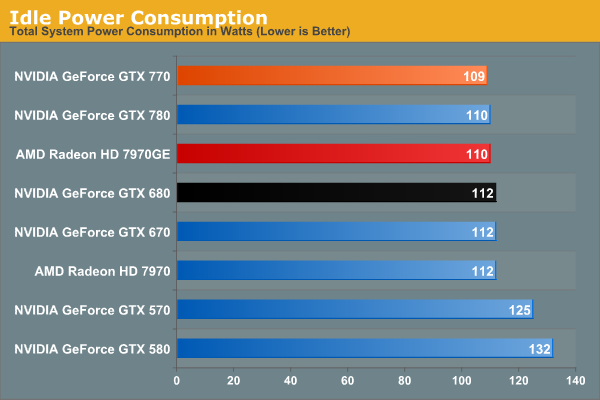
We don’t normally publish this data, but GTX 770 has an extra interesting attribute about it: its idle clockspeed is lower than other Kepler parts. GTX 680 and GTX 780 both idle at 324MHz, but GTX 770 idles at 135MHz. Even 324MHz has proven low enough to keep Kepler’s idle power in check in the past, so it’s not entirely clear just what NVIDIA is expecting here. We’re seeing 1W less at the wall, but by this point the rest of our testbed is drowning out the video card.
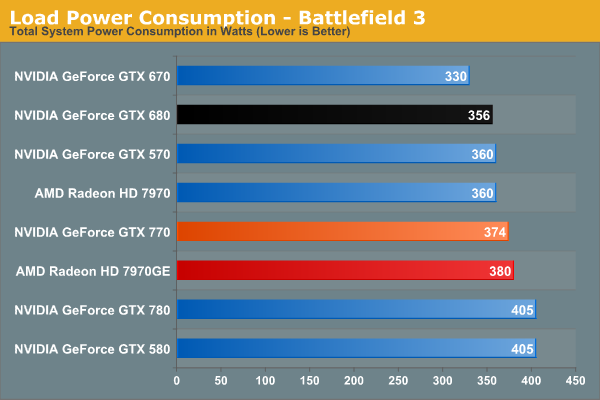
Moving on to BF3 power consumption, we can see the power cost of GTX 770’s performance. 374W at the wall is only 18W more than GTX 680, thanks in part to the fact that GTX 770 isn’t hitting its TDP limit here. At the same time compared to the outgoing GTX 670, this is a 44W difference. This makes it very clear that GTX 770 is not a drop-in replacement for GTX 670 as far as power and cooling go. On the other hand GTX 770 and GTX 570 are very close, even if GTX 770’s TDP is technically a bit higher than GTX 570’s.
Despite this runup, GTX 770 still stays a hair under 7970GE, despite the slightly higher CPU power consumption from GTX 770’s higher performance in this benchmark. It’s only 6W at the wall, but it showcases that NVIDIA didn’t have to completely blow their efficiency curve to get a GK104 card back up to 7970GE performance levels.
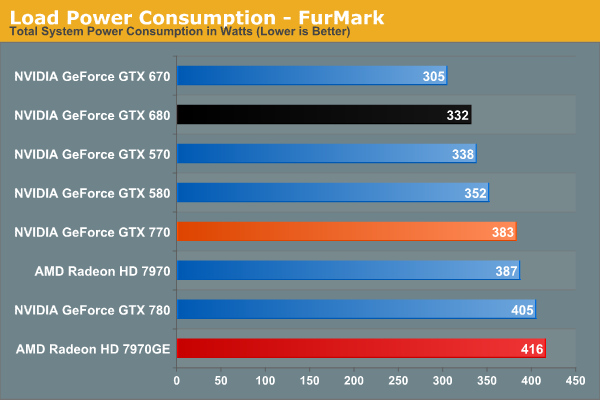
In our TDP constrained scenario we can see the gaps between our cards grow. 78W separates the GTX 770 from GTX 670, and even GTX 680 draws 41W less, almost exactly what we’d expect from their published TDPs. On the flip side of the coin 383W is still less than both 7970 cards, reflecting the fact that GTX 770 is geared for 230W while AMD’s best is geared for 250W.
This is also a reminder however that at a mid-generation product extra performance does not come for free. With the same process and the same architecture, performance increases require power increases. This won’t significantly change until we see 20nm cards next year.
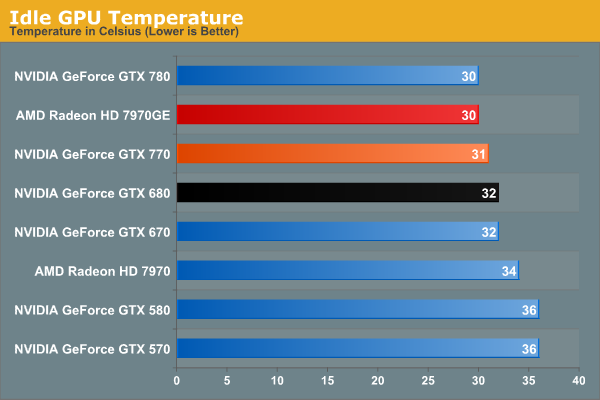
Moving on to temperatures, these are going to be a walk in the part for the reference GTX 770 due to the Titan cooler. At idle we see it hit 31C, which is actually 1C warmer than GTX 780, but this really just comes down to uncontrollable variations in our tests.
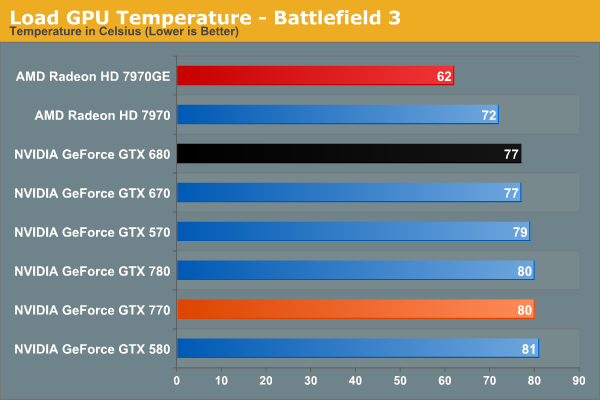
As a GPU Boost 2.0 card temperatures will top out at 80C in games, and that’s exactly what happens here. Interestingly, GTX 770 is just hitting 80C, as evidenced by our clockspeeds earlier. If it was running hotter, it would have needed to drop to lower clockspeeds.
Of course it doesn’t hold a candle here to 7970GE, but that’s the difference between a blower and an open air cooler in action. The blower based 7970 is much closer, as we’d expect.
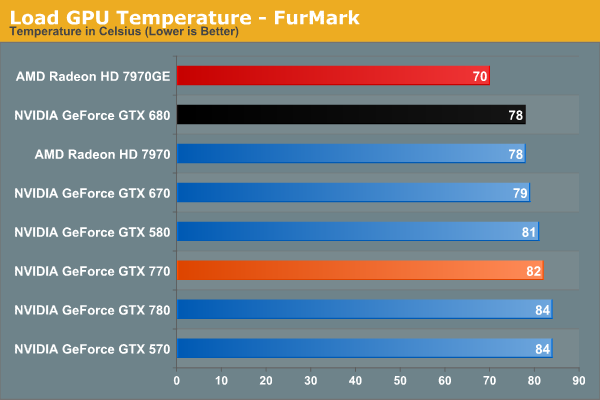
Under FurMark the temperature situation is largely the same. The GTX 770 comes up to 82C here (favoring TDP throttling over temperature throttling), but the relative rankings are consistent.
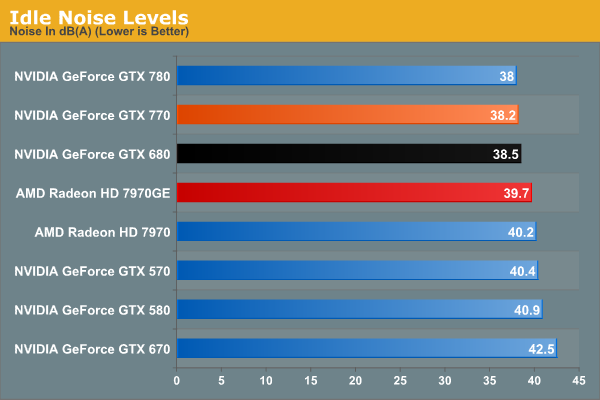
With Titan’s cooler in tow, idle noise looks very good on GTX 770.
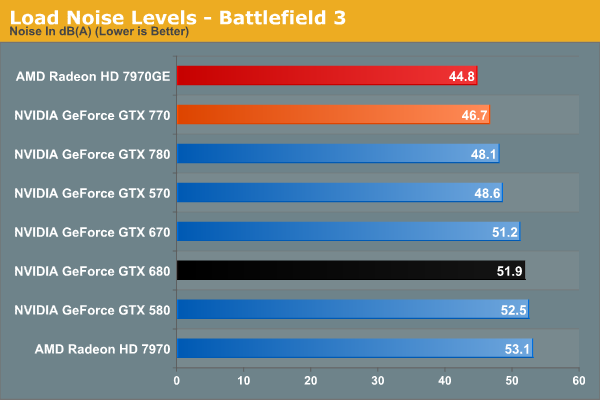
Our noise results under Battlefield 3 are a big part of the reason we’ve been calling the Titan cooler oversized for GTX 770. When is the last time we’ve seen a blower on a 230W card that only hit 46.7dB? The short answer is never. GTX 770’s fan simply doesn’t have to rev up very much to handle the lesser heat output. In fact it’s damn near competitive with the open air cooled 7970GE; there’s still a difference, but it’s under 2dB. More importantly however, despite being a more powerful and more power-hungry card than the GTX 680, the GTX 770 is over 5dB quieter, and this is despite the fact that the GTX 680 is already a solid card own its own. Titan’s cooler is certainly expensive, but it gets results.
Of course this is why it’s all the more a shame that none of NVIDIA’s partners are releasing retail cards with this cooler. There are some blowers in the pipeline, so it will be interesting to see if they can maintain Titan’s performance while giving up the metal.
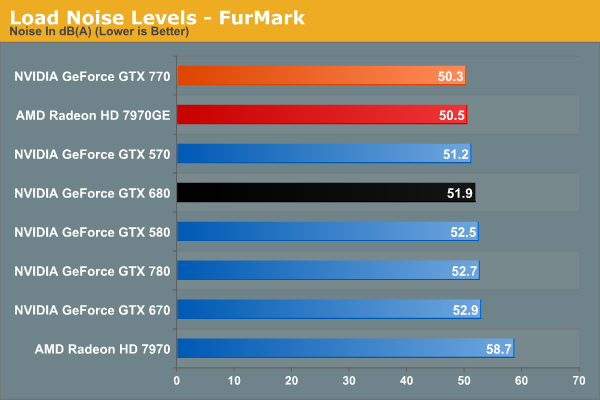
With FurMark pushing our GTX 770 at full TDP, our noise results are still good, but not as impassive as they were under BF3. 50.3dB is still over a dB quieter than GTX 680, though obviously much closer than before. On the other hand the GTX 770 ever so slightly edges out the 7970GE and its open air cooler. Part of this comes down to the TDP difference of course, but beating an open air cooler like that is still quite the feat.
Wrapping things up here, it will be interesting to see where NVIDIA’s partners go with their custom designs. GTX 770, despite being a higher TDP part than both GTX 670 and GTX 680, ends up looking very impressive when it comes to noise, and it would be great to see NVIDIA’s partners match that. At the same time the increased power consumption and heat generation relative to the GeForce 600 series is unfortunate, but not unexpected. But for buyers coming from the GeForce 400 and GeForce 500 series, GTX 770 is in-line with what those previous generation cards were already pulling.










117 Comments
View All Comments
LoccOtHaN - Friday, May 31, 2013 - link
True Bro ;-) AMD is more user friendly, but when Next-Gen on ATI/AMD comes PS4 and M$ XBx1 then all optimalisation will be AMD friendly and DX11.1 (DX11.x or Full DX11) and we won !whyso - Thursday, May 30, 2013 - link
Well looks like the 7970 ghz has been tied. Lower price is nice but almost no OC headroom (wouldn't be surprised if AT got a cherry picked sample) and no game bundle. Similar power consumption too. Performance increase is virtually 0 but the price decrease is nice.A5 - Thursday, May 30, 2013 - link
Worth pointing out that you can pretty easily get the AMD bundle codes for ~$30 on eBay. It wipes out the price advantage, but it does let you weigh the cards on the merits of their hardware.steve_rogers42 - Thursday, May 30, 2013 - link
Think there is an error on page 7,"Of course this is only a 9% increase in the GPU clockspeed, which is going to pale in comparison to parts like GTX 670 and GTX 780, each of which can do 20%+ due to their lower clockspeeds. So there’s some overclocking headroom in GTX 780, but as to be expected not a ton."
Last sentence should read GTX 770 yea?
Great article, good to see nvidia's progress with the GPU boost 2 and taking on-board the tdp/power issue that the 600 series seems to have had. It will be interesting to see what they make of the 760 and what it will contain.
Cheers,
nathanddrews - Thursday, May 30, 2013 - link
Wow... at worst it is equal with the 680 for $100 less. At best, it is tied with the 780 for $250 less. I think NVIDIA needs to reexamine their pricing model - I'm sure the market will fix it for them. Either the 770 is too cheap or the 780 is way too expensive. (signs point to the latter)shompa - Thursday, May 30, 2013 - link
GTX 780 die is huge. It costs Nvidia almost double to manufacture a 780GTX then a 770/680 die.Only if Nvidia have enough harvested defect dies from Tesla chips they could/would lower the price on GTX 780.
EJS1980 - Thursday, May 30, 2013 - link
If the 780 performs better than the 680 by 30-35% out the gate w/ crappy day1 drivers (future updates will only increase that advantage), how exactly is it tied with the 770?nathanddrews - Thursday, May 30, 2013 - link
How exactly is it tied? Like I said, at its best.http://www.anandtech.com/bench/Product/829?vs=827
770 and 780 tied (within +/-5%):
DiRT: Showdown - 1920x1080 - Ultra Quality + 4xMSAA
Sleeping Dogs - 1920x1080 - Ultra Quality + Normal AA
Battlefield 3 - 1920x1080 - Ultra Quality + FXAA-High
Compute: Civilization V
Compute: Sony Vegas Pro 12 Video Render
Synthetic: 3DMark Vantage Pixel Fill
EJS1980 - Thursday, May 30, 2013 - link
Your link shows the 780 with a pretty substantial performance advantage, save for a couple instances. I stand by my comment.nathanddrews - Saturday, June 1, 2013 - link
It's easy to stand by your comment if you completely ignore what I wrote and ignore the facts. For instance, the 680 was not tested with "crappy day1 drivers", it was tested with very recent 320.14 drivers while the 770/780 used 320.18. In addition, I never said that the 770 was always tied with the 780, I said "at its best", which means that at the high end it ties the 780 in some benchmarks. At its worst, on the low end, the 770 is tied with the 680 in some benchmarks. I hope that clarifies things for you.